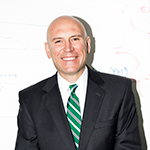
VP & Corporate CIO
Time Warner
Career Advice: “Learn the culture of a business and adapt to it.”
As one of the world’s leading media conglomerates, Time Warner’s technology department must stay on the forefront of innovation in multiple areas. At its corporate head is Kurt Rao, who has been with the company for six years. He works with both vendors and the management of each business department, leading a decentralized corporate technology team. For Rao, one of the benefits of having a such a structure is that the team understands the business and is able to react to its needs. “Reacting to a business from a technological standpoint is difficult if the team isn’t close to it,” he says.
Rao and his team use a “Plan Build Run Govern” philosophy at Time Warner. Team members are assigned to the specific pillar they are best suited for and work to incorporate that pillar’s logic into day-to-day practices. The philosophy has been applied to all internal technological functions, whether for human resources, finance, or real estate, in addition to helping meet external demands from vendors and outside employees.
In his effort to continually transform Time Warner’s technology function, Rao has focused on three main areas: the cloud, mobility, and social- and consumer-based technology. In the cloud realm, the technology team replaced antiquated systems supporting human resources, finance, and real estate processes and focused on implementing standard products and practices across the board for all functions. In mobility, Rao’s team developed applications for tracking employee travel and expenses. And in the final focus area, the team is in the early stages of studying how data can grow and improve the business while providing more revenue. His team is currently identifying the best places to collect data points.
Such projects necessitate change, and Rao says that one of the most difficult challenges has been in change management. Rao’s team is largely decentralized, working globally to support Time Warner in all its markets. For the last six years, they have been focused on moving non-core functions into a federated model, where they can be managed by a small team. Moving the model required a lot of time and effort.
Rao sees technology as an ever-changing field, and recommends for anyone working in the field to continue their education by talking to people, attending conferences, getting input from others, and reading the latest materials to keep pace with new developments. “Right now, it’s important that technology helps people be social and mobile,” Rao says. “Media companies are also transforming from a business-to-business model to a business-to-consumer model, which changes their target markets and the demands that are placed on technology.” Rao also believes that technology is shifting to understand and analyze advanced data, which will help set up platforms for a new set of business rules.
Moreover, such changes have required the IT department to change its perspective, and Rao encourages young people entering the field to understand that while IT is a technology-oriented function, it’s the people that convey the importance of that technology and teach others how to leverage it optimally. “It’s important to understand how IT works,” he explains. “But it’s also very important to be customer-service oriented.”
Rao has had numerous mentors over the years and recognizes that good mentors are willing to give the opportunity to learn, even if the mentee is inexperienced. A good mentor will also teach the value of risk—when to take a risk, how to take a risk, and how much of a risk to take. In the IT realm, Rao believes a successful leader needs to focus on three things: the customer’s needs and doing everything they can to meet them; fostering relationships with their customers so that they improve the business or services provided; and constantly building, motivating, and inspiring their IT team. A key tenant of this approach is to train leaders to speak the language of the business, as it’s not the business’s responsibility to understand the language of IT. Rao believes that people have to occasionally create opportunities and find innovative ways to bring about change, especially since technology itself is always progressing.















